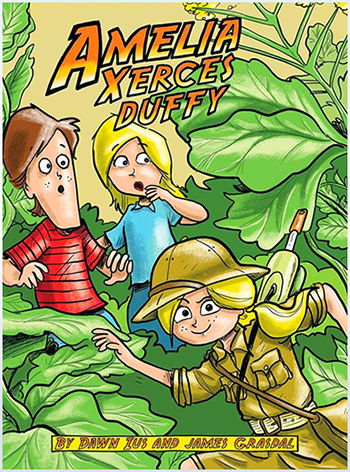
Grade 1 Learning Objectives for “Ameila Xerces Duffy”
Jump to Subject

English Language Arts
General Learning Objective
1. Students will listen, speak, read, write, view and represent to explore thoughts, ideas, feelings and experiences.
Specific Learning Objectives
1.1 Discover and explore
Express ideas and develop understanding
- Share personal experiences that are clearly related to oral, print and other media texts
- Talk with others about something recently learned
- Make observations about activities, experiences with oral, print and other media texts
Experiment with language and forms
- Experiment with different ways of exploring and developing stories, ideas and experiences
1.2 Clarify and Extend
Consider the ideas of others
- Listen and respond appropriately to experiences and feelings shared by others
Extend understanding
- Ask questions to get additional ideas and information on topics of interest
General Learning Objective
2. Students will listen, speak, read, write, view and represent to comprehend and respond personally and critically to oral, print and other media texts.
Specific Learning Objectives
2.1 Use Strategies and Cues
Use prior knowledge
- Use knowledge of how oral language is used in a variety of contexts to construct and confirm meaning
- Use previous experience and knowledge of oral language to make connections to the meaning of oral, print and other media texts
- Use knowledge of context, pictures, letters, words, sentences, predictable patterns and rhymes in a variety of oral, print and other media texts to construct and confirm meaning
- Use knowledge of print, pictures, book covers and title pages to construct and confirm meaning
Use comprehension strategies
- Talk about print or other media texts previously read or viewed
- Identify the main idea or topic of simple narrative and expository texts
Use textual cues
- Preview book cover, pictures and location of text to assist with constructing and confirming meaning
2.2 Respond to Text
Experience various texts
- Participate in shared listening, reading and viewing experiences, using oral, print and other media texts from a variety of cultural traditions and genres, such as poems, storytelling by elders, pattern books, audiotapes, stories and cartoons
Construct meaning from texts
- Relate aspects of stories and characters to personal feelings and experiences
- Retell interesting or important aspects of oral, print and other media texts
- Tell or represent the beginning, middle and end of stories
- Tell, represent or write about experiences similar or related to those in oral, print and other media texts
- Tell what was liked or disliked about oral, print and other media texts
2.3 Understand Forms, Elements and Techniques
Understand forms and genres
- Distinguish differences in the ways various oral, print and other media texts are organized
Understand techniques and elements
- Tell what characters do or what happens to them in a variety of oral, print and other media texts
General Learning Objective
3. Students will listen, speak, read, write, view and represent to manage ideas and information.
Specific Learning Objectives
3.1 Plan and Focus
Focus attention
- Explore and share own ideas on topics of discussion and study
- Connect information from oral, print and other media texts to topics of study
3.2 Select and Process
Access information
- Use text features, such as illustrations, titles and opening shots in video programs, to access information
- Use questions to find specific information in oral, print and other media texts
3.3 Organize, Record and Evaluate
Evaluate information
- Recognize and use gathered information to communicate new learning
3.4 Share and Review
Share ideas and information
- Share ideas and information from oral, print and other media texts with familiar audiences
- Answer questions directly related to texts
General Learning Objective
4. Students will listen, speak, read, write, view and represent to enhance the clarity and artistry of communication.
Specific Learning Objectives
4.3 Present and Share
Demonstrate attentive listening and viewing
- Ask questions to clarify information
- Be attentive and show interest during listening or viewing activities

Science
General Learning Objective
1–1 Bring focus to investigative activities, based on their own questions and those of others.
Specific Learning Objectives
Focus
- Ask questions that lead to exploration and investigation
- Predict what they think will happen or what they might find
Reflect and Interpret
- Describe what was observed, using pictures and oral language
- Identify questions being investigated and identify what was learned about each question
- Identify new questions that arise from what was learned.
General Learning Objective
1–4 Demonstrate positive attitudes for the study of science and for the application of science in responsible ways.
Specific Learning Objectives
Students will show growth in acquiring and applying the following traits:
- Curiosity
- Confidence in personal ability to explore materials and learn by direct study
- A willingness to work with others and to consider their ideas
- Respect for living things and environments, and commitment for their care.
Topic A: Creating Colour
General Learning Objective
1–5 Identify and evaluate methods for creating colour and for applying colours to different materials.
Specific Learning Objectives
- Identify colours in a variety of natural and manufactured objects.
- Compare and contrast colours, using terms such as lighter than, darker than, more blue, brighter than.
Topic D: Senses
General Learning Objective
1–9 Use the senses to make general and specific observations, and communicate observations orally and by producing captioned pictures.
Specific Learning Objectives
- Identify each of the senses, and explain how we use our senses in interpreting the world.
- Identify ways that our senses contribute to our safety and quality of life.
- Apply particular senses to identify and describe objects or materials provided and to describe living things and environments. Students meeting this expectation will be able to describe characteristics, such as colour, shape, size, texture, smell and sound.
Topic D: Senses
General Learning Objective
1–10 Describe the role of the human senses and the senses of other living things, in enabling perception and action.
Specific Learning Objectives
- Identify each of the senses, and explain how we use our senses in interpreting the world.
- Identify ways that our senses contribute to our safety and quality of life.
- Apply particular senses to identify and describe objects or materials provided and to describe living things and environments. Students meeting this expectation will be able to describe characteristics, such as colour, shape, size, texture, smell and sound.
Topic E: Needs of Animals and Plants
General Learning Objective
1–11 Describe some common living things, and identify needs of those living things.
Specific Learning Objectives
1. Observe, describe and compare living things
3. Identify ways in which living things are valued; e.g., as part of a community of living things; as sources of food, clothing or shelter.
4. Classify some common local plants and animals into groups on the basis of visible characteristics; e.g., adaptations for survival, such as claws, beaks, prickles.
6. Identify the requirements of animals to maintain life; i.e., air, food, water, shelter, space; and recognize that we must provide these for animals in our care
7. Identify the requirements of plants to maintain life; i.e., air, light, suitable temperature, water, growing medium, space and recognize that we must provide these for plants in our care
